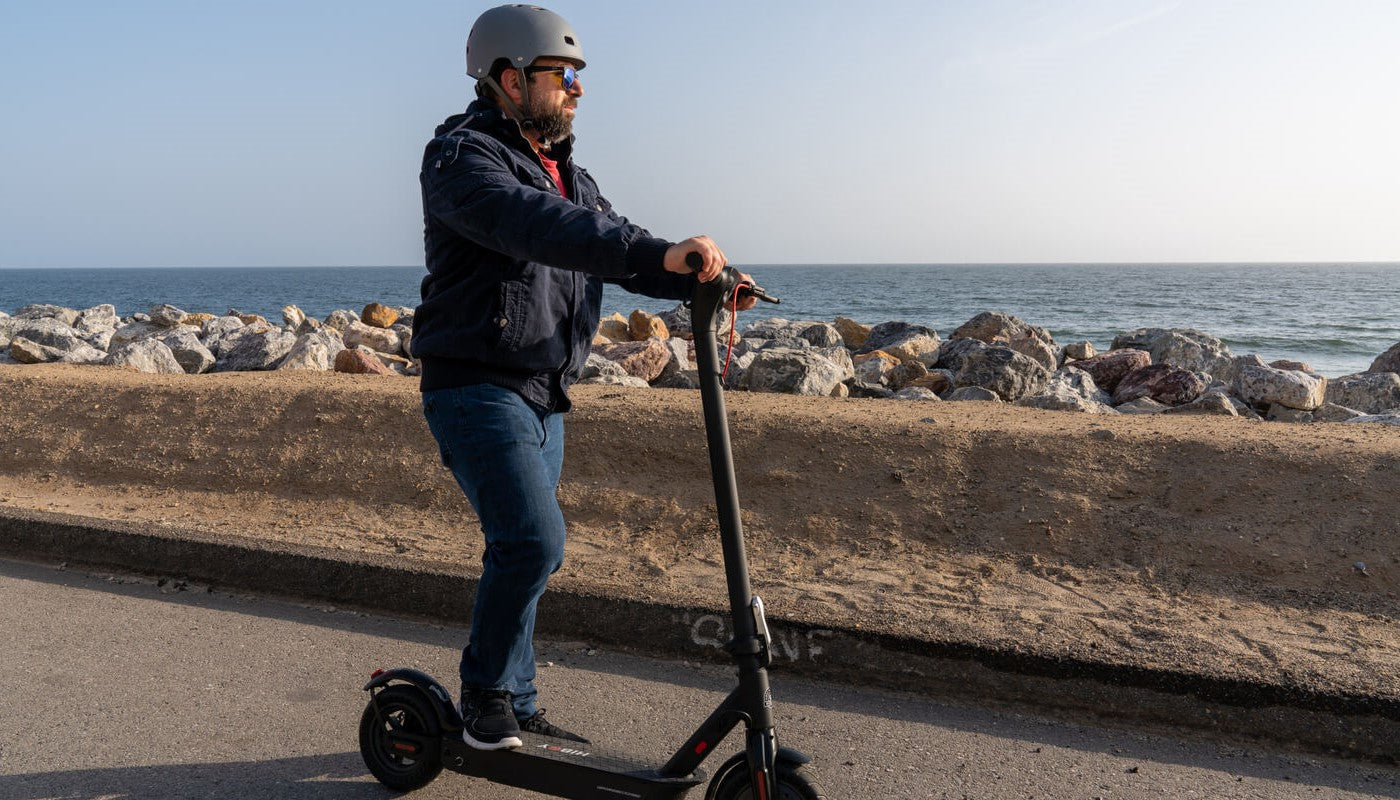With the rapid development of electric mobility tech, the prevalence of electric scooters on urban thoroughfares is increasingly conspicuous. For the reason that rides an electric scooter is easier than a bicycle and travelling around is more effortless, therefore most people take up trying to commute to the workplace or back home by an e-scooter.
Here are some guides and tips you should know as a beginner.
What are the basics of an electric scooter and how does it work?
An electric scooter is a portable, lightweight vehicle that runs on an electric brushless DC motor (General power at 250W, some products can reach 500W or even more)
) powered by rechargeable batteries, and are still other significant components such as the throttle, the controller and the brakes.
While the rider activates the throttle, the controller reacts and sends a variable signal by the strength of the throttle twist to the motor at once, the activated motor rotates the gear to turn the wheels, scooter begins to move forward. The rider can control the speed of the scooter using the throttle and can slow down or stop using the brakes. The battery provides the electrical energy necessary to power the motor and keep the scooter moving.
Choosing the Right Electric Scooter for You
Before choosing an appropriate electric scooter, something you should know about the restrain of e-scooter laws in your country or states
- Age restrictions: In many places, there are age restrictions for riding electric scooters. For example, some cities require riders to be at least 16 years old to ride on public roads.
- Helmet laws: Some jurisdictions require riders to wear helmets when riding an electric scooter, regardless of age.
- Speed limits: Many areas impose speed limits for electric scooters. For example, in Canada, the maximum speed of an e-scooter is limited to 20 mph.(Our S2 Series products perfectly fit the speed limit of electric scooters in Canadian law)
- Riding on sidewalks: In many places, electric scooters are not allowed on sidewalks and must be ridden on the road or designated bike lanes.
- Parking regulations: Electric scooters must be parked in designated areas, and leaving them in prohibited areas can result in fines or other penalties.
- Insurance requirements: Some jurisdictions require electric scooter riders to have liability insurance.
There are several important factors to consider when choosing an e-scooter. One such factor is the top speed of the scooter, next to the rider's weight, suspension and range.
Top speed
It's important to choose a model that is fast enough for your needs, but not so fast that it requires a license or violates relevant local laws and policies. The top speed means how fast your e-scooter can go at a full twist throttle, most e-scooters have a maximum speed of between 20 and 30 mph.
It’s crucial to consider the maximum speed when it comes to your daily ride, nobody wants to spend hours of time commuting because of speed.
Weight
The weight can be a significant factor to be considered because it directly affects the portability of an e-scooter. Typically, an e-scooter weighs between 25 and 50 lbs and is foldable for the convenience of storing and carrying. Therefore, if the scooter is too heavy, it loses some portability.
Suspension
Incorporating a suspension system into your electric scooter can greatly enhance your riding experience, particularly when traversing off-road terrain. A suspension system not only enables your e-scooter to glide smoothly but also prevents damage to its frame and body when riding over rough or uneven surfaces, so please notice whether the e-scooter has a good suspension when you choose it.
Range
The range can be affected by serval factors such as the weight of the vehicle and rider, the average speed in riding, the motor power and the battery capacity. So the actual riding distance of an electric scooter is generally less than the ideal value given by the manufacturer, before you purchase it, you should understand and accept the difference in advance.
Safety Tips and Guidelines for Electric Scooter Riders
- Wear a helmet: Wearing a helmet can protect your head while riding your electric scooter. It can help prevent serious injuries in case you encounter the event of an accident.
- Check your e-scooter before each ride: It’s necessary to check your scooter is in good condition before hitting the road. Make sure the brakes, tires, and other important parts are working properly.
- Avoid distracted riding: Don't use your phone or other devices while riding your electric scooter, keep your attention on the road, your surroundings, and the cars suddenly rushed out.
- Use designated bike lanes or paths: Whenever possible, use designated bike lanes or paths for your e-scooter. This can help keep you safe and reduce the risk of accidents with other vehicles.
- Watch your speed: Pay attention to your speed and adjust it according to the road conditions. Slow down in crowded areas or when riding on uneven terrain, and please familiarize your brakes’ performance in advance, knowing the braking distance of your e-scooter can avoid you collide others in an emergency.
- Don't carry passengers: Most electric scooters are designed for one person only. Please avoid carrying passengers to prevent accidents and maintain control of your e-scooter.
- Be visible: Make yourself visible to other road users by wearing bright or reflective clothing and using lights on your electric scooter when riding in low-light conditions.
Other questions you might consider about:
How do I practice riding an electric scooter?
As a rookie, it is essential to practice in a safe and empty environment before venturing out onto the roads. Find an empty parking lot or block and spend time driving your scooter around, practicing your acceleration, braking, and turning until you feel comfortable doing so. Once you have gained confidence, you can progress to a slow street and gradually increase your speed as you become more comfortable with your scooter. Remember to always prioritize safety and wear appropriate protective gear while riding.
Do you have to fully charge an electric scooter before first use?
You could charge and test if the e-scooter is working well when you first receive it, after making sure there are no problems, it’s necessary to fully charge the battery when you are ready to use it formally.
Can you use an e-scooter in the rain?
Nowadays, most e-scooter products can prevent damage from water splashing, but when it comes to heavy rain conditions, It depends on whether your e-scooter is water-proof according to IPX4 standards. If it rains a lot in your area, you may want to focus on buying an IPX4-compliant e-scooter.











Share:
Hiboy is Coming to Canada: Join the Movement Towards Sustainable and Fun Mobility
8 Reasons Why You Need an Electric Bike?